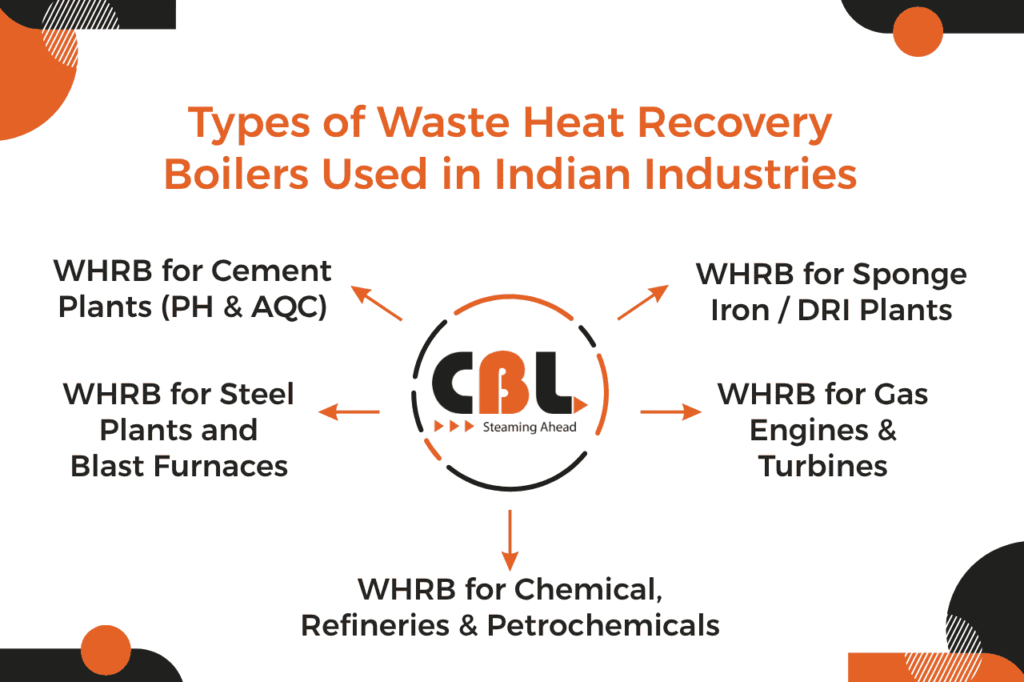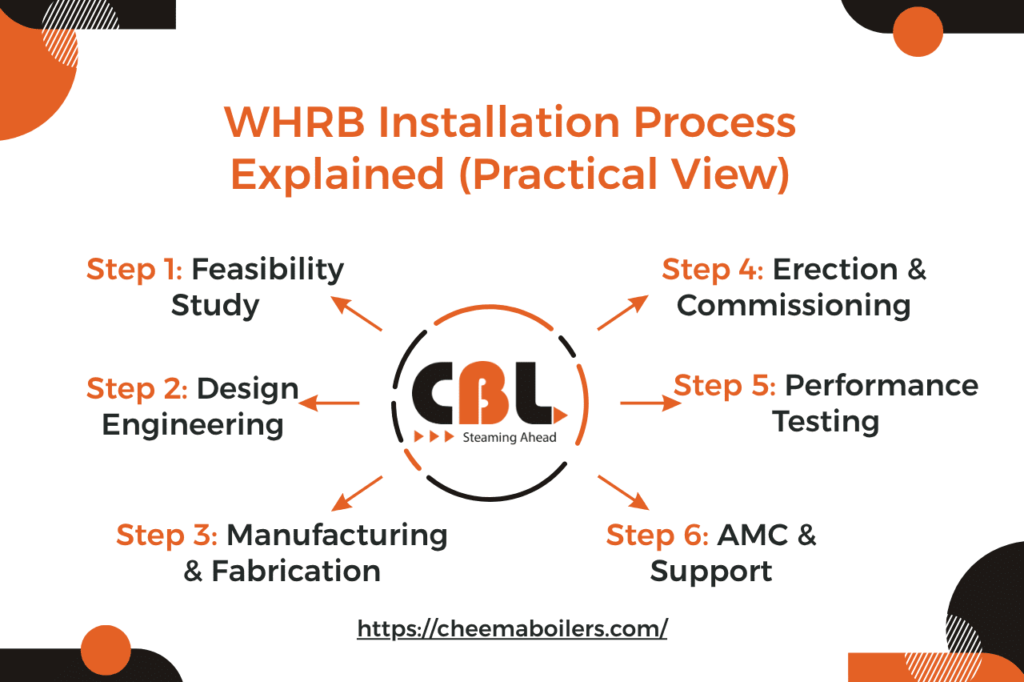India’s industrial landscape is undergoing a major transformation. With rising energy costs, strict emission regulations, and a growing focus on sustainability, industries are actively searching for technologies that reduce fuel consumption while improving overall plant efficiency. Waste Heat Recovery Boilers (WHRBs) have emerged as one of the most cost-effective solutions for achieving this.
Waste heat is released from various industrial processes—cement kilns, sponge iron kilns, blast furnaces, gas turbines, diesel engines, chemical reactors, exhaust stacks, and more. Traditionally, this heat used to escape into the atmosphere unused. But today, with modern WHRB technology, industries can convert this lost energy into useful steam or power, significantly reducing their operating costs.
Understanding Waste Heat Recovery Boilers (WHRB)
A Waste Heat Recovery Boiler is a system designed to capture heat from exhaust gases generated during industrial processes. This recovered heat is then used to:
Generate steam
Heat thermal fluid
Preheat combustion air
Produce hot water
Generate electricity through a turbine
Reduce the energy load on fired boilers
WHRBs are highly efficient because they use heat that is otherwise wasted — meaning the fuel consumption does not increase to generate this steam or power.
Why WHRB Technology Matters Today
As industries are under pressure to cut emissions and energy costs, WHRBs provide:
Reduced fossil fuel use
Lower electricity bills
Higher plant efficiency
Reduced carbon footprint
Longer equipment life
Improved sustainability score
Types of Waste Heat Recovery Boilers Used in Indian Industries

Different industries generate different types of exhaust gases. Cheema Boilers manufactures WHRBs that match these industry needs. The main types include:
WHRB for Cement Plants (PH & AQC Boilers)
Cement plants in India are among the largest adopters of WHRB systems. Cheema Boilers offers:
PH Boiler (Preheater Boiler)
AQC Boiler (Air Quenching Cooler Boiler)
These boilers recover heat from:
Preheater exit gases
Clinker cooler exhaust
This recovered heat is used to generate power, significantly cutting electricity costs for cement manufacturers.
WHRB for Sponge Iron / DRI Plants
Sponge iron (DRI) kilns emit hot flue gases above 900°C. WHRBs here generate high-quality steam that can be used to:
Run turbines
Power captive plants
Reduce load on primary boilers
CBL designs robust WHRBs that withstand high dust loads and corrosive gases common in DRI units.
WHRB for Steel Plants and Blast Furnaces
Steel mills produce enormous amounts of waste heat from:
Hot stoves
Electric arc furnaces (EAF)
Blast furnaces (BF)
Sinter machines
WHRBs in steel plants help reduce the plant’s energy dependency and decrease emissions significantly.
WHRB for Gas Engines & Turbines
Industries operating:
Gas engines
Diesel engines
Gas turbines
can install heat recovery boilers to utilize high-temperature exhaust gases. The recovered heat generates steam, improving CHP (Combined Heat & Power) efficiency.
WHRB for Chemical, Refineries & Petrochemicals
Process plants often release large quantities of heat through:
Reformers
Reactors
Crackers
Incinerators
Cheema Boilers offers customized WHRB designs for these complex processes.
How WHRBs Work: Technical Overview
Though WHRBs come in many designs, the basic function remains the same.
Step-by-Step Working Process
Collection of Hot Exhaust Gas
The exhaust gas exits the process and enters the WHRB through ducts.
Heat Transfer to Water/Steam
Hot gases pass through tubes or over tubes, transferring heat to water.
Generation of Steam
The heat converts water into steam at the desired pressure.
Steam Utilization
The steam is used for:
- Power generation
- Process heating
- Captive consumption
Clean Exhaust Release
The cooled exhaust gases exit the boiler through the stack, now much less harmful.
Key Benefits of Waste Heat Recovery Boilers for Indian Industries
WHRB installations provide both economic and environmental benefits.
Reduction in Fuel Costs
Since WHRB steam is generated without burning additional fuel, industries can reduce:
Coal consumption
Gas consumption
Furnace oil bills
Reduction in Electricity Bills
Steam from WHRBs can run turbines and generate free electricity, drastically reducing dependence on grid power.
Improved Overall Plant Efficiency
By capturing waste heat, the plant achieves overall higher thermal efficiency.
Reduction in Carbon Footprint
A WHRB can reduce CO₂ emissions by thousands of tonnes per year.
Long-Term ROI
Typical return on investment ranges from 1.5 to 4 years, depending on application.
WHRB Design Features (What Makes a Good Boiler)
Cheema Boilers designs WHRBs that include:
✔ High-efficiency heat transfer surfaces
✔ Custom-engineered tube layouts
✔ IBR-compliant design
✔ Pressure ranges from low to very high
✔ Dust-handling capability for DRI/cement
✔ Horizontal & vertical configurations
✔ Long operating life
✔ Low maintenance downtime
Cost of Waste Heat Recovery Boilers in India

WHRB cost varies based on:
Industry type
Gas temperature
Dust load
Steam pressure
Steam quantity
Customization
General WHRB Price Range in India:
| Industry | Approx. WHRB Cost (INR) |
|---|---|
| Cement Plant | ₹4 Cr – ₹25 Cr |
| Sponge Iron / DRI | ₹3 Cr – ₹18 Cr |
| Steel Plant | ₹5 Cr – ₹30 Cr |
| Gas Engines/Turbines | ₹2 Cr – ₹12 Cr |
| Chemical & Process Plants | ₹3 Cr – ₹20 Cr |
Cost-Saving Potential
A well-designed WHRB can save ₹3 crore to ₹30 crore per year depending on plant size.
Why Cheema Boilers (Mohali) Is the Leading WHRB Manufacturer in India
Cheema Boilers is recognized across India for delivering reliable and efficient WHRB systems.
Strong Engineering & Design Expertise
CBL engineers have decades of experience in heat transfer, thermodynamics, and boiler design.
Proven Track Record
Successful WHRB installations across:
Cement
DRI
Steel
Chemical
Power
Petrochemical
Fertilizer
High Customization Capability
Unlike generic boiler manufacturers, Cheema Boilers offers 100% customized WHRBs to suit:
Plant layout
Gas temperature
Steam pressure
Space availability
Budget
IBR Certified Boilers
All boilers are manufactured according to Indian Boiler Regulations (IBR).
In-House Manufacturing Facility (Mohali)
State-of-the-art facility ensures:
Precision fabrication
High-quality welding
Strict QC/QA
Short delivery timelines
Strong After-Sales Support
Includes:
Installation
Commissioning
Annual maintenance
Emergency response
Industries That Need WHRB in India
Industries with high energy demand or high exhaust gas temperatures benefit greatly:
✔ Cement plants
✔ Sponge iron/DRI plants
✔ Steel mills
✔ Refineries
✔ Chemical plants
✔ Fertilizer units
✔ Gas turbine & diesel engine power plants
✔ Coke ovens
✔ Glass factories
✔ Thermal power plants
WHRB Installation Process Explained (Practical View)

Cheema Boilers follows a structured execution process:
Step 1: Feasibility Study
Analysis of waste heat availability, space, and ROI calculations.
Step 2: Design Engineering
Thermodynamic modeling and mechanical design.
Step 3: Manufacturing & Fabrication
Production at Mohali facility.
Step 4: Erection & Commissioning
On-site installation by expert engineers.
Step 5: Performance Testing
Ensures guaranteed output and efficiency.
Step 6: AMC & Support
Ongoing maintenance to maximize boiler life.
Future of Waste Heat Recovery in India
The future is very promising due to:
✔ Increasing energy prices
✔ Government focus on carbon reduction
✔ Mandatory energy audits (for designated industries)
✔ Push for self-generated power in industries
WHRB adoption is expected to grow significantly over the next decade.
Conclusion: Why Waste Heat Recovery Boilers Are No Longer Optional
In today’s competitive environment, industries cannot afford to lose energy through exhaust gases. Waste Heat Recovery Boilers offer measurable advantages:
Lower operating costs
Higher profitability
Reliability in operations
Eco-friendly compliance
With proven expertise, Cheema Boilers (Mohali) stands as a trusted partner in delivering high-performance Waste Heat Recovery Boilers across India.
Industries that adopt WHRB technology now will enjoy long-term savings, stronger sustainability scores, and higher productivity.
Call to Action
If your industry generates waste heat and you want to reduce fuel consumption and electricity costs, Cheema Boilers can help.
📞 Contact Cheema Boilers (CBL), Mohali
For WHRB design, pricing, feasibility studies, and complete turnkey solutions.

